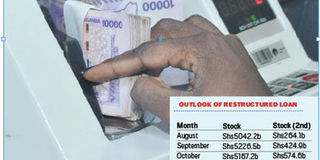Restructured loans hit Shs7.9 trillion

Banks have been restructuring loans since April 2020 as they seek to offer customers relief. PHOTO/FILE.
What you need to know:
- Under the Credit Relief Measure, the Central Bank seeks to allow borrowers deal with the unfavorable impact of Covid-19 on their ability to repay loans as well as reduce the risk of exposure for banks.
At least loans worth Shs7.9 trillion have been restructured since April 2020 under the Credit Relief Measure, according to Bank of Uganda.
Data from the Central Bank indicates that Shs7.9 trillion worth of loans has been restructured, of which, Shs4.8 trillion remains outstanding.
“Shs764.5b of restructured loans are past due [while] Shs.612.8 billion [are] in the watchful category,” said Bank of Uganda in the February 2021 Monetary Report.
Real estate, which has 29 per cent of restructured loans, according to the Central Bank report, has the largest share of restructured loans followed by trade at 23 per cent and agriculture at 13 per cent.
However, Bank of Uganda warned that if economic activity does not pick up, there is a risk that restructured loans which are due might progress into non-performing loans.
The report indicated that non-performing loans as a share of total loans stood at 5.3 per cent as of December 2020.
The Credit Relief Measure, in which a number of loans have been rescheduled, had sought to provide borrowers relief due to a slowdown in economic activities and growth.
The measures, the Central Bank announced last, would be extended by another six months to allow borrowers deal with the unfavorable impact of Covid-19 on their ability to repay loans as well as reduce the risk of exposure for banks.
During the period, Bank of Uganda said commercial banks’ interests rate on shillings-denominated loans averaged at 18.8 per cent in the quarter to December 2020 down from 20.2 per cent while interest on foreign exchange-denominated loans rose to 6.1 per cent from 5.7 per cent.
The Central Bank also noted significant advances to prime customers during December 2020, especially telecoms to finance capital expenditure, meet license renewal fees and pay year-end corporate taxes.
Private sector credit from financial corporations such as Uganda Development Bank grew by 10.2 per cent in December 2020 from 9.5 per cent, partly because of gradual recovery and growing demand for low cost credit.
Stock of UDB loans stood at Shs516b in December from Shs.406b in September and Shs333b in December 2019.
Net extensions by banks picked even as they remain pre-Covid-19 levels.
There was an increase in both value of loan demands and supply within the quarter to December.
Value of loan applications increased to Shs4.9 trillion from Shs4.2 trillion September while approved loans increased from Shs2.9b to Shs.2.7b in the period.
Central Bank data indicates that private sector credit, excluding UDB, stood at 7.4 per cent in the quarter to December up from 6.9 per cent in September.
The market, Bank of Uganda noted have remained relatively stable in line with policy interventions such as liquidity support measures in which two banks have so far accessed a total of Shs244b.




